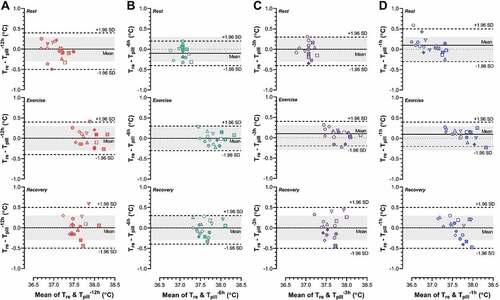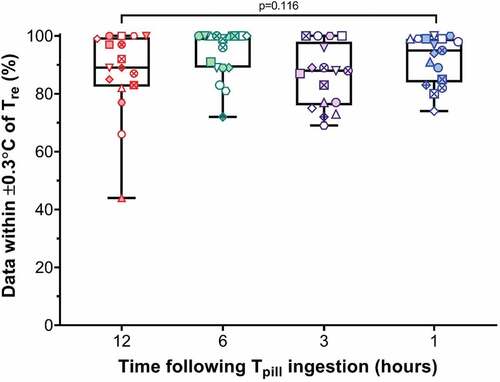Figures & data
Figure 1. Panel A: A schematic of the time points at which temperature pills were ingested: 12, 6, 3 and 1 hour(s) prior to data collection within each experimental trial (Exp. trial). Since trials commenced at ~12:00 pm, this meant that participants consumed each pill at 12:00 am (midnight) (Tpill−12 h), 6:00 am (Tpill−6 h), 9:00 am (Tpill−3 h), and 11:00 am (Tpill−1 h), before inserting a rectal temperature probe (Tre) prior to the trial. Panel B: An example of time-dependent changes in all temperature indices (1-min averages) from one subject during one of the two experimental trials. Each trial involved 15-min rest, 90-min of cycling eliciting a metabolic heat production of ~200 W/m2 in dry heat (40°C, ~20% relative humidity), and 45-min recovery. Each trial differed only in the pattern of external work performed, with one involving a constant external work rate of 40 W/m2 and the other involving alternating cycles of 5 min at 15 W/m2 then 5 min at 60 W/m2. The gray zones denote the times at which data were extracted for statistical comparisons. Panel C: An example of time-dependent changes in all temperature indices (1-min averages) for the same subject in Panel B, but this time presented as a difference from rectal temperature. The gray zone shows the error threshold (±0.3°C) we considered to be acceptable, with data points falling within this area being used to assess agreement between each pill and rectal temperature (see “Data and statistical analysis” for details).

Table 1. Statistical comparisons of the mean and mean squared errors for rectal temperature and each ingestible pill.
Figure 2. Bland-Altman plots showing agreement between rectal temperature (Tre) and gastrointestinal temperature pills ingested 12 (Tpill−12; A), 6 (Tpill−6 h; B), 3 (Tpill−3 h; C) and 1 hour(s) (Tpill−1 h; D) prior to data collection. Data were obtained from nine participants who completed two trials involving 15-min rest, 90-min cycling eliciting an average metabolic heat production of ~200 W/m2, followed by 45-min recovery in dry heat (40°C, ~20% relative humidity), with data presented as averaged of the final 10-min of rest, exercise and recovery. Each trial differed only in the pattern of external work performed, with one involving a constant external work rate of 40 W/m2 and the other involving 10-min cycles of 5 min at 15 W/m2 then 5 min at 60 W/m2 (variable-intensity exercise). Each subject has a unique symbol, with the open and shaded symbols representing the constant- and variable-intensity exercise trials, respectively. The dotted gray lines show zero bias, the solid black lines show the mean bias, and the dashed black lines show the limits of agreement (mean bias ±1.96 SD). All limits of agreement fell on or outside of the acceptance threshold (±0.3°C) defined a priori (gray shaded zone), indicating that none of the temperature pills could be used interchangeably with rectal temperature to assess core temperature.

Figure 3. Box-plots showing the median, interquartile range and min/max for the percentage of measurements (1-min intervals) from each pill falling within our pre-established acceptance threshold (±0.3°C from rectal temperature) across the entire 150 min protocol (gray zone in )). These percentages were compared across ingestion times using a Friedman test, with Dunn’s multiple comparison test being used in the event of significant main effect. between rectal temperature (Tre) and temperature pills ingested 12 (Tpill−12; A), 6 (Tpill−6 h; B), 3 (Tpill−3 h; C) and 1 hour(s) (Tpill−1 h; D) prior to data collection. Data were obtained from nine participants who ingested temperature pills 12, 6, 3 and 1 hour(s) prior to completing two trials involving 15-min rest, 90-min cycling eliciting an average metabolic heat production of ~200 W/m2, followed by 45-min recovery in dry heat (40°C, ~20% relative humidity). Each trial differed only in the pattern of external work performed, with one involving a constant external work rate of 40 W/m2 and the other involving 10-min cycles of 5 min at 15 W/m2 then 5 min at 60 W/m2 (variable-intensity exercise). Each subject has a unique symbol, with the open and shaded symbols representing the constant- and variable-intensity exercise trials, respectively. No statistically significant differences were observed across ingestion times (p = 0.116).

